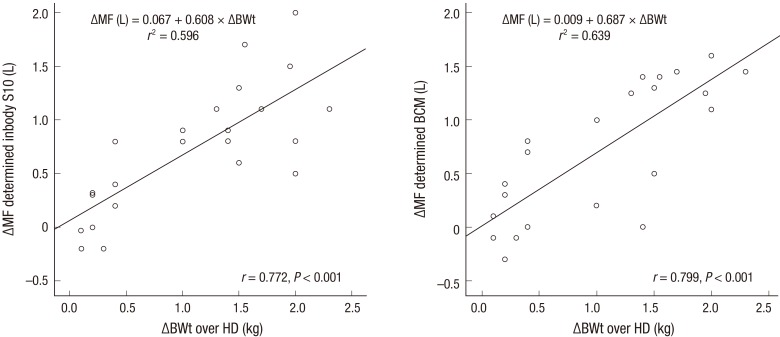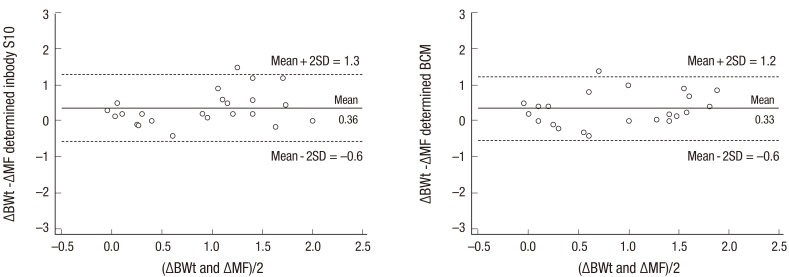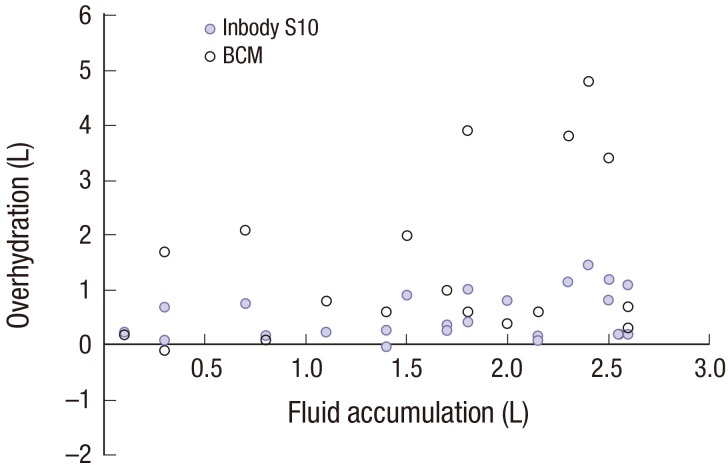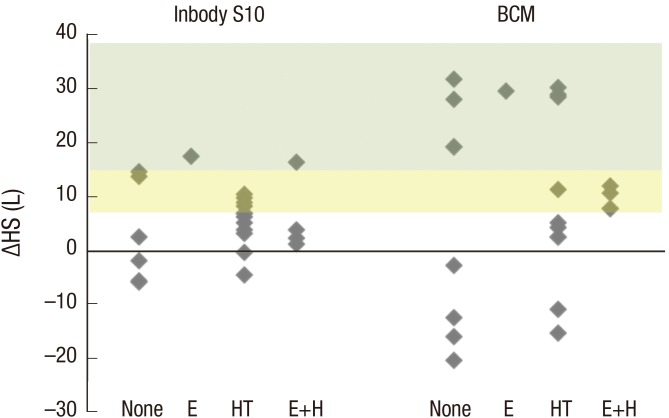J Korean Med Sci.
2017 Nov;32(11):1828-1834. 10.3346/jkms.2017.32.11.1828.
Measurement of Fluid Status Using Bioimpedance Methods in Korean Pediatric Patients on Hemodialysis
- Affiliations
-
- 1Department of Pediatrics, Chonnam National University Hospital, Gwangju, Korea.
- 2Department of Pediatrics, Seoul National University Children's Hospital, Seoul National University College of Medicine, Seoul, Korea. pedneph@snuh.org
- 3Department of Pediatrics, Hallym University Kangnam Sacred Heart Hospital, Seoul, Korea.
- KMID: 2390310
- DOI: http://doi.org/10.3346/jkms.2017.32.11.1828
Abstract
- Adequate fluid management is an important therapeutic goal of dialysis. Recently, bioelectrical impedance methods have been used to determine body fluid status, but pediatric reports are rare. To determine the accuracy of bioelectrical impedance methods in the assessment of body fluid statusof children undergoing hemodialysis (HD), 12 children on HD were studied. A multi-frequency bioimpedance analysis device (Inbody S10) and bioimpedance spectroscopy device (BCM) were used to evaluate fluid status. Fluid removal during a HD session (assessed as body-weight change, ΔBWt) was compared with the difference in total body water determined by each device (measured fluid difference, ΔMF), which showed strong correlation using either method (Pearson's coefficient, r = 0.772 with Inbody S10 vs. 0.799 with BCM). Bioimpedance measurement indicated fluid overload (FO; ΔHS greater than 7%) in 34.8% with Inbody S10 and 56.5% with BCM, and only about 60% of children with FO by bioimpedance methods showed clinical symptoms such as hypertension and edema. In some patients with larger weight gain Inbody S10-assessed overhydration (OH) was much smaller than BCM-assessed OH, suggesting that BCM is more relevant in estimating fluid accumulation amount than Inbody S10. To our knowledge, this is the first report on the use of body composition monitors to assess fluid status in Korean children receiving HD.
Keyword
MeSH Terms
Figure
Cited by 2 articles
-
Normal Reference Plots for the Bioelectrical Impedance Vector in Healthy Korean Adults
Jun-Hyok Oh, Seunghwan Song, Harin Rhee, Sun Hack Lee, Doo Youp Kim, Jeong Cheon Choe, Jinhee Ahn, Jin Sup Park, Myung Jun Shin, Yun Kyung Jeon, Hye Won Lee, Jung Hyun Choi, Han Cheol Lee, Kwang Soo Cha
J Korean Med Sci. 2019;34(30):. doi: 10.3346/jkms.2019.34.e198.Association Between Changes in Bioelectrical Impedance Analysis (BIA) Parameter and the Clinical Outcomes in Patients With Acute Heart Failure
Kyu-Sun Lee, Jae-hyoung Kim, Jeehoon Kang, Hyun-Jai Cho, Hae-Young Lee
J Korean Med Sci. 2023;38(35):e276. doi: 10.3346/jkms.2023.38.e276.
Reference
-
1. Wizemann V, Wabel P, Chamney P, Zaluska W, Moissl U, Rode C, Malecka-Masalska T, Marcelli D. The mortality risk of overhydration in haemodialysis patients. Nephrol Dial Transplant. 2009; 24:1574–1579. PMID: 19131355.2. Frank Peacock W, Soto KM. Current technique of fluid status assessment. Congest Heart Fail. 2010; 16(Suppl 1):S45–S51. PMID: 20653711.3. Kotanko P, Levin NW, Zhu F. Current state of bioimpedance technologies in dialysis. Nephrol Dial Transplant. 2008; 23:808–812. PMID: 18182405.4. Moissl UM, Wabel P, Chamney PW, Bosaeus I, Levin NW, Bosy-Westphal A, Korth O, Müller MJ, Ellegård L, Malmros V, et al. Body fluid volume determination via body composition spectroscopy in health and disease. Physiol Meas. 2006; 27:921–933. PMID: 16868355.5. Ellis KJ, Shypailo RJ, Wong WW. Measurement of body water by multifrequency bioelectrical impedance spectroscopy in a multiethnic pediatric population. Am J Clin Nutr. 1999; 70:847–853. PMID: 10539745.6. Liu A, Byrne NM, Ma G, Nasreddine L, Trinidad TP, Kijboonchoo K, Ismail MN, Kagawa M, Poh BK, Hills AP. Validation of bioelectrical impedance analysis for total body water assessment against the deuterium dilution technique in Asian children. Eur J Clin Nutr. 2011; 65:1321–1327. PMID: 21731041.7. Kim YJ, Jeon HJ, Kim YH, Jeon J, Ham YR, Chung S, Choi DE, Na KR, Lee KW. Overhydration measured by bioimpedance analysis and the survival of patients on maintenance hemodialysis: a single-center study. Kidney Res Clin Pract. 2015; 34:212–218. PMID: 26779424.8. Davies SJ, Davenport A. The role of bioimpedance and biomarkers in helping to aid clinical decision-making of volume assessments in dialysis patients. Kidney Int. 2014; 86:489–496. PMID: 24918155.9. Van Biesen W, Williams JD, Covic AC, Fan S, Claes K, Lichodziejewska-Niemierko M, Verger C, Steiger J, Schoder V, Wabel P, et al. Fluid status in peritoneal dialysis patients: the European Body Composition Monitoring (EuroBCM) study cohort. PLoS One. 2011; 6:e17148. PMID: 21390320.10. Yu SJ, Kim DH, Oh DJ, Yu SH, Kang ET. Assessment of fluid shifts of body compartments using both bioimpedance analysis and blood volume monitoring. J Korean Med Sci. 2006; 21:75–80. PMID: 16479069.11. Brooks ER, Fatallah-Shaykh SA, Langman CB, Wolf KM, Price HE. Bioelectric impedance predicts total body water, blood pressure, and heart rate during hemodialysis in children and adolescents. J Ren Nutr. 2008; 18:304–311. PMID: 18410888.12. Allinovi M, Saleem MA, Burgess O, Armstrong C, Hayes W. Finding covert fluid: methods for detecting volume overload in children on dialysis. Pediatr Nephrol. 2016; 31:2327–2335. PMID: 27282380.13. Zaloszyc A, Schaefer B, Schaefer F, Krid S, Salomon R, Niaudet P, Schmitt CP, Fischbach M. Hydration measurement by bioimpedance spectroscopy and blood pressure management in children on hemodialysis. Pediatr Nephrol. 2013; 28:2169–2177. PMID: 23832099.14. Hofsteenge GH, Chinapaw MJ, Weijs PJ. Fat-free mass prediction equations for bioelectric impedance analysis compared to dual energy X-ray absorptiometry in obese adolescents: a validation study. BMC Pediatr. 2015; 15:158. PMID: 26471899.15. Wells JC, Williams JE, Chomtho S, Darch T, Grijalva-Eternod C, Kennedy K, Haroun D, Wilson C, Cole TJ, Fewtrell MS. Pediatric reference data for lean tissue properties: density and hydration from age 5 to 20 y. Am J Clin Nutr. 2010; 91:610–618. PMID: 20089731.16. Buckinx F, Reginster JY, Dardenne N, Croisiser JL, Kaux JF, Beaudart C, Slomian J, Bruyère O. Concordance between muscle mass assessed by bioelectrical impedance analysis and by dual energy X-ray absorptiometry: a cross-sectional study. BMC Musculoskelet Disord. 2015; 16:60. PMID: 25887598.17. Basso F, Milan Manani S, Cruz DN, Teixeira C, Brendolan A, Nalesso F, Zanella M, Ronco C. Comparison and reproducibility of techniques for fluid status assessment in chronic hemodialysis patients. Cardiorenal Med. 2013; 3:104–112. PMID: 23922550.18. Chamney PW, Wabel P, Moissl UM, Müller MJ, Bosy-Westphal A, Korth O, Fuller NJ. A whole-body model to distinguish excess fluid from the hydration of major body tissues. Am J Clin Nutr. 2007; 85:80–89. PMID: 17209181.19. Wabel P, Moissl U, Chamney P, Jirka T, Machek P, Ponce P, Taborsky P, Tetta C, Velasco N, Vlasak J, et al. Towards improved cardiovascular management: the necessity of combining blood pressure and fluid overload. Nephrol Dial Transplant. 2008; 23:2965–2971. PMID: 18458032.20. Bland JM, Altman DG. Statistical methods for assessing agreement between two methods of clinical measurement. Lancet. 1986; 1:307–310. PMID: 2868172.21. Dionisio P, Valenti M, Bergia R, Caramello E, Stramignoni E, Berto IM, Pellerey M, Bajardi P. Influence of the hydration state on blood pressure values in a group of patients on regular maintenance hemodialysis. Blood Purif. 1997; 15:25–33. PMID: 9096904.22. Thomasset MA. Bioelectric properties of tissue. Impedance measurement in clinical medicine. Significance of curves obtained. Lyon Med. 1962; 94:107–118. PMID: 13920843.23. Kyle UG, Bosaeus I, De Lorenzo AD, Deurenberg P, Elia M, Gómez JM, Heitmann BL, Kent-Smith L, Melchior JC, Pirlich M, et al. Bioelectrical impedance analysis--part I: review of principles and methods. Clin Nutr. 2004; 23:1226–1243. PMID: 15380917.24. Jung HW, Jang IY, Lee YS, Lee CK, Cho EI, Kang WY, Chae JH, Lee EJ, Kim DH. Prevalence of frailty and aging-related health conditions in older Koreans in rural communities: a cross-sectional analysis of the aging study of Pyeongchang rural area. J Korean Med Sci. 2016; 31:345–352. PMID: 26952571.25. VanderJagt DJ, Okolo SN, Rabasa AI, Glew RH. Bioelectrical impedance analysis of the body composition of Nigerian children with sickle cell disease. J Trop Pediatr. 2000; 46:67–72. PMID: 10822931.26. Papakrivopoulou E, Booth J, Pinney J, Davenport A. Comparison of volume status in asymptomatic haemodialysis and peritoneal dialysis outpatients. Nephron Extra. 2012; 2:48–54. PMID: 22619667.27. Kraemer M, Rode C, Wizemann V. Detection limit of methods to assess fluid status changes in dialysis patients. Kidney Int. 2006; 69:1609–1620. PMID: 16501488.28. Onofriescu M, Hogas S, Voroneanu L, Apetrii M, Nistor I, Kanbay M, Covic AC. Bioimpedance-guided fluid management in maintenance hemodialysis: a pilot randomized controlled trial. Am J Kidney Dis. 2014; 64:111–118. PMID: 24583055.29. Martinoli R, Mohamed EI, Maiolo C, Cianci R, Denoth F, Salvadori S, Iacopino L. Total body water estimation using bioelectrical impedance: a meta-analysis of the data available in the literature. Acta Diabetol. 2003; 40(Suppl 1):S203–S206. PMID: 14618473.
- Full Text Links
- Actions
-
Cited
- CITED
-
- Close
- Share
- Similar articles
-
- Estimation of Body Fluid Volume by Bioimpedance Spectroscopy in Patients with Hyponatremia
- Assessment of Fluid Shifts of Body Compartments using Both Bioimpedance Analysis and Blood Volume Monitoring
- The Experience of Fluid Management in Hemodialysis Patients
- Clinical usefulness of bioimpedance analysis for assessing volume status in patients receiving maintenance dialysis
- Overhydration measured by bioimpedance analysis and the survival of patients on maintenance hemodialysis: a single-center study





